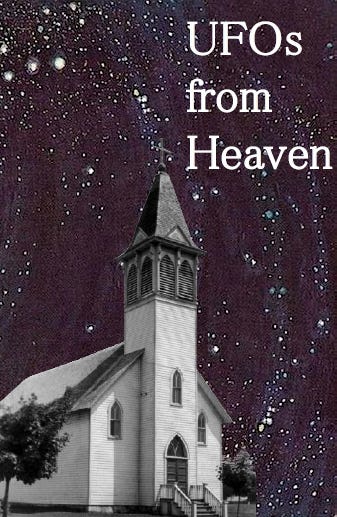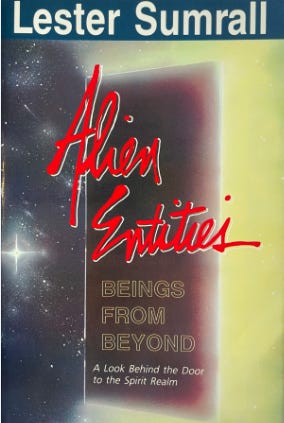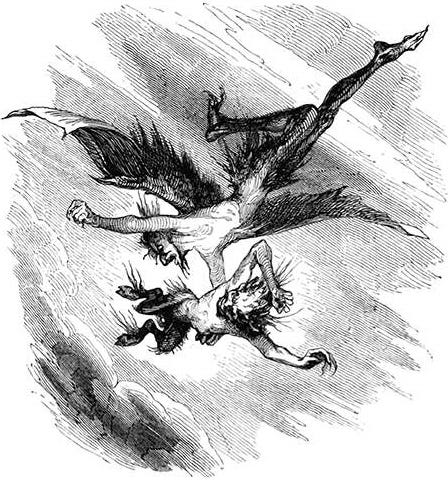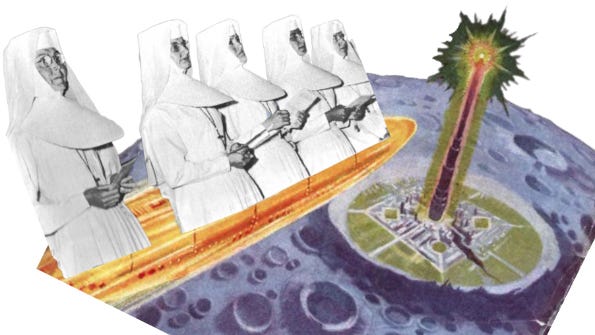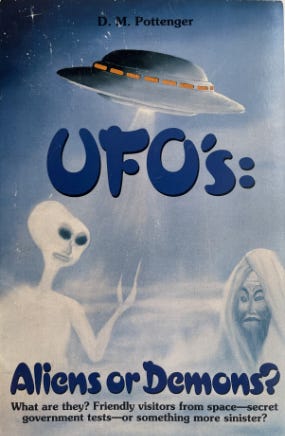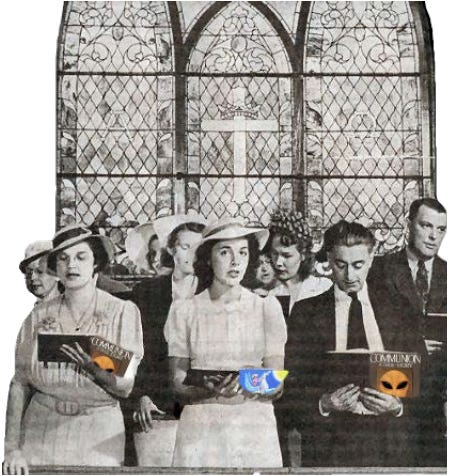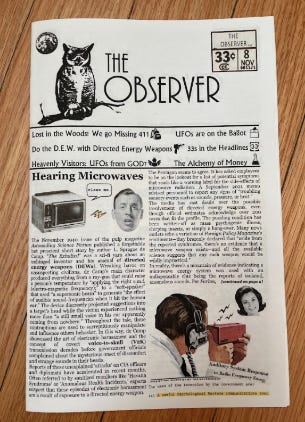Even before the Protestant Reformation, factions of Christianity coalesced around distinct theological interpretations of the Bible. With differences of opinion on everything from the saints to salvation, it’s no surprise that they don’t agree on the reality about UFOs and their potential occupants. Some denominations insist that the mysterious objects sighted in our skies are part of a sinister spiritual deception, others entertain the possibility that intelligent alien life might be another one of God’s wondrous creations.
A sampling of contemporary Christian literature and religious material provides a glimpse into the nuanced views and explanations for the UFO phenomenon.
Dr. Lester Sumrall was a Full Gospel minister with more books under his belt than Nick Redfern. Full Gospel churches stem from a branch of Pentecostalism that believe miracles performed in the New Testament—things like speaking in tongues or casting out demons—continue to happen in the same way today. Sumrall became internationally famous in 1953 when he performed an exorcism on a young Manila resident named Clarita.
In 1984, Sumrall wrote and self-published Alien Entities: Beings From Beyond, a book about the proliferation of demons on earth. His ‘aliens’ were the fallen angels from Genesis that supposedly accompanied Lucifer when he was cast out of heaven. The pastor identified these sinful spirits that “originate among the stars” as the source of UFO reports and ET visitations. He explained how these “foreigners” dwell in the spirit world, but possess the power to break through the invisible wall that separates their realm from humanity’s.
Sumrall’s literal interpretation of Ephesians 2:2—which refers to Lucifer as “the prince of the power of the air”—leads him to conclude that “demons principally live in the air above the earth.” More specifically, he distinguished between the “three heavens” that are alluded to in the Bible, explaining that Earth is the ‘1st Heaven,’ the air/atmosphere constitutes ‘2nd Heaven,’ and the ‘3rd Heaven’ is God’s kingdom. In his estimation, 2nd Heaven was the “primary abode of alien entities,”—a region occupied by Satan and his demons—and the place from which “they invade the planet earth.”
Alien Entities includes other passages that suggests the devil’s dominance goes beyond the sky. He cites other instances of demons inhabiting territory underneath the earth or “brought out of deep waters.” Sumrall even considers another far-out possibility: “It could be possible that the headquarters of the devil is on the moon.” The theory is unique but has little to do with a connection between Satan and UFOs. He speculated that since people seemed to respond in strange ways to the phases of the Moon, it was possible that the devil could have a residence there. He admitted that this conjecture wasn’t supported by scripture.
Sumrall wrote that the UFO topic was inherently evil. He lamented the fact that “extra-terrestrial personalities have become a craze in our country.” In his view, Hollywood’s “green men from outer space” were demons in disguise. Seeing this as part of a larger agenda to “prepare the world to recognize and receive alien entities,” the growing appeal of space-visitors in popular culture amounted to a distraction from God’s wonders.
Through the lens of his faith, Sumrall detected a “satanic purpose” behind films like Spielberg’s E.T. It wasn’t a tale about a harmless lost alien, it was a story featuring “a being, supposedly from outer space, a creature with powers beyond normal”—a demon. This sentiment was shared by Christian authors John Weldon and Zola Levitt in their book, UFO’s: What on Earth is Happening? (1975). The duo summed up a common outlook on the implications of UFO activity: “Here’s where we think the UFO’s come in. To properly set the stage for the Antichrist, who really is a supernatural personality, the world has to be made ready to think in terms of the new and the strange.”
For all of its fire and brimstone, Alien Entities concluded that Christians have nothing to fear from Satan’s aliens. Embracing the Full Gospel approach to devil confrontation, Sumrall’s message was that every true believer has the power within to “cast him out, to send him back to the void of space, off the planet earth.”
J.D. Johnson is a retired pastor who wrote a small, 80-page booklet represented as “a feasible and cogent analysis of the UFO phenomenon” from a Seventh-day Adventists’ perspective. Adventist doctrine observes the Sabbath on Saturday instead of Sunday and teaches that the biblical end-times are imminent. This belief that the apocalypse is “soon coming,” directly influenced Signs of the Saucers’ perception of the curious things going on in the sky. The result is a book that maintains a suspicious attitude about the origin and intentions of alleged ‘extraterrestrial’ interlopers.
Johnson doesn’t doubt the reality of the UFO experience, confirming that “mounting evidence shows that sightings and human abductions connected with them are not hoaxes.” He believes that these intricate deceptions are “marvelous works of delusion,” which the Bible predicted would precede the earth’s final days. He agrees with other Christian authors who believe that aliens are nothing more than “demons ... disguised as beings from another planet,” but emphasizes that the “unprecedented” number of sightings and abductions reported in the last half-century are eschatologically relevant—an indication that Lucifer and his fallen angels are fulfilling an end-times prophecy foretold in the Book of Revelation.
Johnson fears that the devil might use a “UFO-Flying Saucer Event” to “convince the world that he is the expected Christ” and usher in a New World Order. He sees flying saucers as the devil’s “final fiasco” with all the makings of “the vanguard of Satan’s main event.”
Johnson started investigating UFOs in the 1950s during an era when people were claiming to have contact and conversations with extraterrestrials. Drawing from UFO material as well as scripture, he explains how these supernatural events overlap with biblical descriptions of the Antichrist.
Using stories told by famous ‘contactee’ George Adamski about experiences with off-world “saucermen,” Johnson points out how Adamski’s aliens deceptively associated themselves with Jesus. In a scene from his book, Inside the Space Ships (1955), the alien is “the master,” while Adamski is referred to as “my son”—monikers that have meaningful connotations to Christians. ‘The master’ told Adamski that he had arrived to “enlighten” the people of Earth and warned him that the planet was in “grave danger.” Johnson recognizes these tactics from 2 Corinthians, which warns Christians to be wary of “false apostles” and Satan “masquerading as an angel of light.”
The author begins to depart from his theological-peers when he speculates that the devil might be colluding with rival denominations to “inspire an unholy alliance between Protestantism, Romanism, and Spiritualism.” Some Adventist teachings hold that the unification of these elements will occur in the end-times, and Johnson believes that the arrival of UFOs on Earth could hasten their cohesion.
He also shares an interesting interpretation of Ephesians’ “prince of the power of the air” verse and Satan’s relationship to the Sun (an aerial object). After some theological gymnastics, Johnson makes the case that worshiping on Sunday is connected to pagan solar-deification and the potential arrival of a luminous sun-like “supernatural wonder or UFO illusion” that could herald the apocalypse.
Though light on page count, Johnson’s book is heavy on vocabulary: He examines the phenomenon “in the kaleidoscope of divine revelation;” concludes that “the UFO guise threatens the world as the most encompassing and masterful counterpart of Satan’s personal counterfeit of Christ’s second coming;” and bemoans the fact that “the vast majority of Christians are spiritually asleep to the spiritual conflict and contention taking place within the UFO enigma and its community.” His emphatic language highlights an underlying sense of urgency brought about by the presence of unidentified aerial visitors.
Are otherworldly visitors intelligent extraterrestrials or demonic entities? A book by Doris M. Pottenger considers the spiritual nature of UFOs from an evangelical Christian perspective. Pottenger is not a preacher or reverend. Her analysis relies more on the late conspiracy theorist Bill Cooper’s testimony than Bible verses (she called Cooper “an expert on the government’s knowledge of UFOs” and credited his cassette tapes as an important primary source). Perhaps because of this influence, her work focuses on the darker aspects of the UFO mythos, and she interprets the creatures’ pattern of malicious actions as “an invasion of evil.”
In the short volume, Pottenger appraises common elements of UFO against the background of her religious beliefs. She derides author Whitley Strieber’s personal abduction account from his book, Communion (1987), calling him “obscene” for suggesting that his intrusive ‘alien’ visitors were sent “from God.” She backs up this accusation by citing the tales of abused abductees gathered by psychologist Dr. Edith Fiore, whose research highlights a pattern of hostility on the part of the abductors. In Pottenger’s view, these actions establish so-called ETs as “cruel, heartless, malignant monsters with no conscience.” They aren’t intelligent beings created on another planet by God, “they are satanic demons, and their leader is none other than Satan himself!”
Accepting as fact the stories of human-animal-extraterrestrial hybridization experiments rumored to be taking place in secret underground bases near Dulce, New Mexico, Pottenger provides biblical proof that the devil is comfortable in these subterranean environments. Revelation 12:9 confirms that Lucifer was “cast out into the earth.” When God later asked Satan of his whereabouts in Job 1:7, he replied that he had been “coming to and fro in the earth, and from walking up and down in it.” Like similar Christian authors, Pottenger interprets this verse literally and relegates the devil to spaces below ground.
Pottenger was also suspicious of the “Grey” aliens that seemed to be consistent characters across different alien encounter stories. While witnesses’ physical descriptions of ETs vary widely, somehow they “all manage to have the little Greys around.”
She suggests that they might be “highly technical robots” or “mutations” created by “intelligent beings (demons).” The Bible states that Satan’s ultimate sin was his desire to “become like the most High” (Isaiah 14:14), and Pottenger submits that these “atrocities” are the devil’s failed efforts to manufacture life— an attempt to imitate the Creator.
UFOs: Aliens or Demons? wasn’t the only book to suspect Grey humanoid ETs might actually be fabricated minions from Hell. J.D. Johnson, author of Signs of the Saucers, also concluded that any ‘alien’ bodies recovered by the government must be “synthetic humanoids” and not some form of intelligent organic life. Since Christians believe that only God possesses the power to create living organisms, the devil’s Grey creatures are either lifeless androids, or physical manifestations of demons themselves.
In many ways, Pottenger sings from the same hymnal as other voices in her field: She believes that ETs and their craft aren’t from God, so they’re inherently devilish. UFO inhabitants are simply “Satan and his demon angels, in disguise at this time as aliens.” She warns that these wonders in the sky are signs that “we are indeed in the final days;” even wondering whether the author of Revelation was describing UFOs and black helicopters when writing verses about “a star fallen from heaven to the earth” and locusts descending from above (Rev 9).
Perhaps most pressingly, Pottenger’s book cautions readers to remain vigilant against the supernatural UFO threat that she believes is trying to “undermine our faith in God.”







